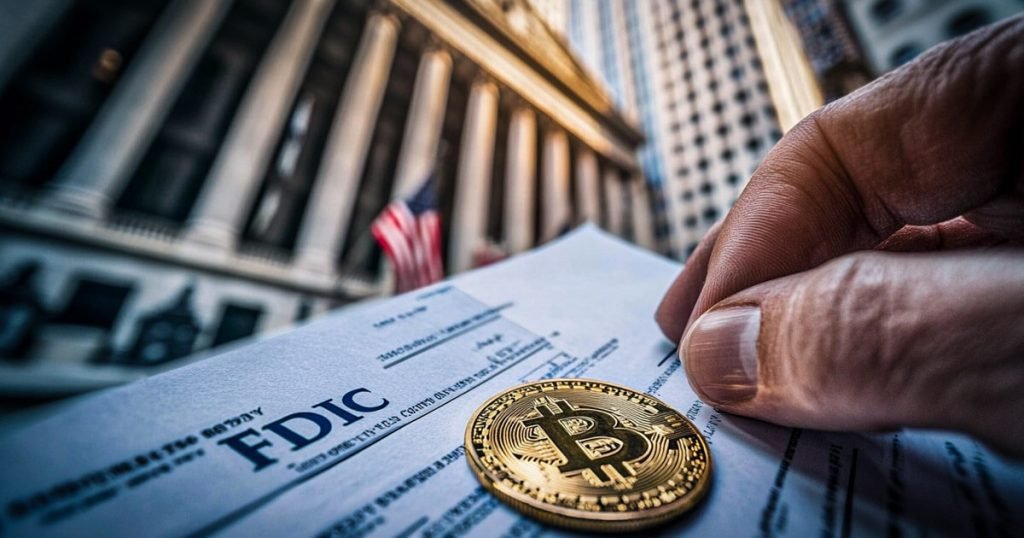FDIC’s New Guidance on Crypto-Related Activities: A Shift Towards Innovation and Clarity
On March 28, 2025, the Federal Deposit Insurance Corporation (FDIC) announced a groundbreaking change in its approach to cryptocurrency by issuing new guidance that allows FDIC-supervised banks to engage in crypto-related activities without prior approval from the agency. This decision, articulated in Financial Institution Letter (FIL-7-2025), rescinds the previous FIL-16-2022 and signifies a major policy shift aimed at encouraging banks to safely integrate digital assets into their service offerings. Acting Chairman Travis Hill emphasized that this action represents a critical turning point for the FDIC, aiming to lay out a coherent framework for financial institutions to operate within the evolving landscape of crypto and blockchain technologies.
The FDIC’s recent guidance reflects an acknowledgment of previous missteps while addressing digital assets. For years, several banks pursuing digital asset activities faced informal “pause” letters that required them to halt their engagement with crypto-related services, such as custody and tokenized deposits. Industry experts alleged that these actions were part of “Operation Chokepoint 2.0,” which they viewed as a strategy by the prior administration to stifle the growth of the crypto sector in the United States. Hill has openly criticized these practices for their lack of transparency, arguing that the FDIC’s prior method of intervention has discouraged innovation and left banks without clear public guidance on how to proceed with crypto services.
In his address, Hill pointed out the flawed enforcement tactics that involved informal communication rather than formal rulemaking processes. Over 20 instances were cited where banks received notices to cease or delay their crypto activities, further underscoring the need for clearer and more systematic regulatory protocols. The latest guidance aims to differentiate the FDIC’s stance from past practices that contributed to uncertainty among financial institutions in the crypto space, allowing them to explore innovative products and services without fear of arbitrary enforcement actions.
The FDIC’s shift is set against the backdrop of ongoing collaboration with the President’s Working Group on Financial Markets, which is exploring additional guidance and strategies for coordinating with other regulatory agencies on digital assets. Bo Hines, the Executive Director of the Presidential Working Group on Digital Asset Markets, hailed the FDIC’s announcement as a significant leap forward toward fostering innovation and wider acceptance of cryptocurrency in traditional banking. This cooperative effort marks a tangible step towards establishing a comprehensive and harmonized regulatory environment for digital assets in the U.S.
Moreover, Hill’s guidance emphasizes that compliance with the Bank Secrecy Act (BSA) should not serve as a pretext for restricting access to conventional banking services. There are ongoing discussions within the FDIC about allowing banks to proceed with tokenized deposit services and other blockchain-based financial infrastructures without the burden of excessive regulatory impediments. This reevaluation seeks to balance the regulatory framework with the necessity for innovation, paving the way for banks to operate responsibly while taking part in the burgeoning digital asset sector.
As the FDIC aligns its policies more closely with other regulatory bodies, including the U.S. Securities and Exchange Commission (SEC), industry players and legislators are urging for consistent and transparent guidelines to facilitate lawful crypto-related services. The current trend marks a response to mounting pressure from stakeholders within the crypto ecosystem who advocate for regulatory clarity. By adopting a more open, supportive approach, the FDIC empowers banks to leverage new technologies and services that are essential in today’s fast-evolving financial landscape, ultimately fostering a robust and innovative framework for the future of finance.
In conclusion, the FDIC’s latest guidance not only represents a progressive step towards supporting the integration of cryptocurrency activities within the banking sector but also addresses the regulatory inconsistencies of the past. As U.S. financial institutions recalibrate their approach to crypto, the FDIC’s commitment to safety, soundness, and innovation may establish a new paradigm for banks navigating the complexities of digital assets. The agency’s forward-looking policies can potentially transform the financial services landscape, bridging the gap between traditional banking and blockchain technology while ensuring consumer protections and financial stability remain paramount.


